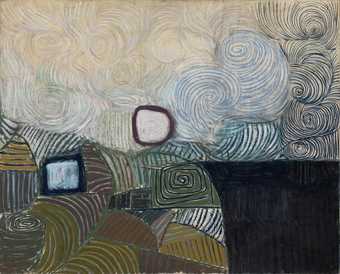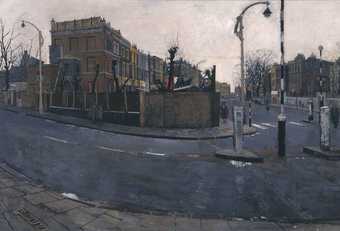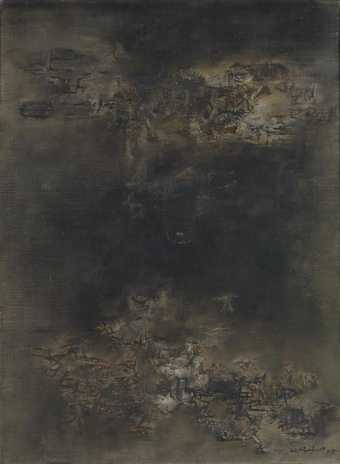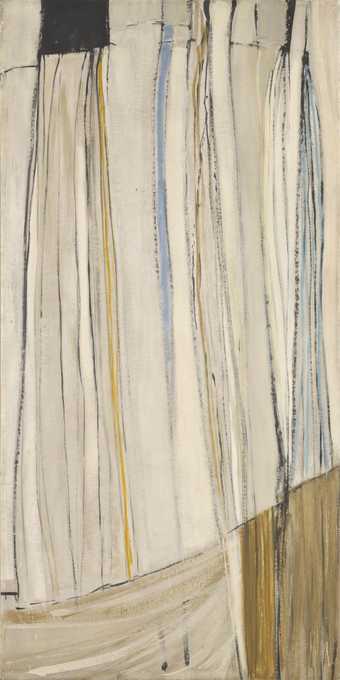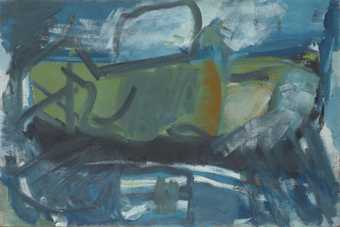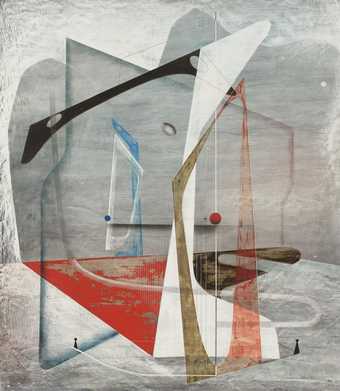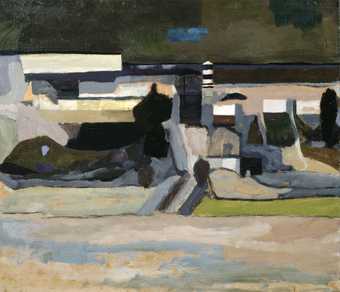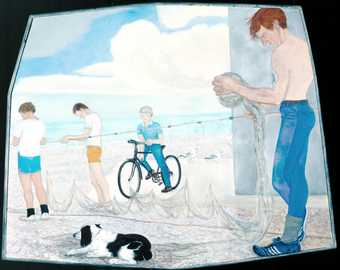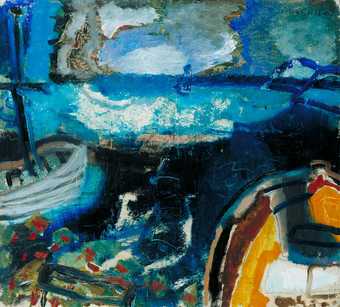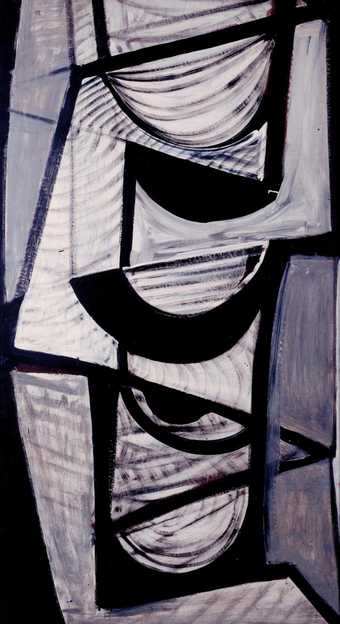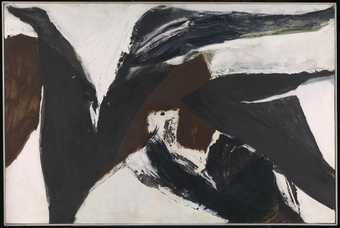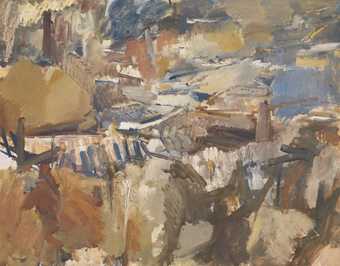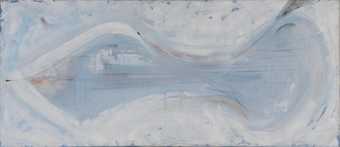
Not on display
- Artist
- Joan Eardley 1921–1963
- Medium
- Oil paint on board
- Dimensions
- Support: 1097 × 2087 mm
frame: 1115 × 2105 × 52 mm - Collection
- Tate
- Acquisition
- Presented by the Friends of the Tate Gallery 1986
- Reference
- T04133
Display caption
Joan Eardley studied at Glasgow School of Art and lived in the city from 1940 to 1961. In 1950 she discovered the small fishing village of Catterline on the east coast of Scotland, and was captivated by the place. She rented cottages there from 1950 to 1961, when Catterline became her permanent home. Fishermen caught crabs and lobster in summer and cod and haddock in winter. There was also a salmon season from February to August when these fish were caught in bag nets. The nets were stretched out to dry on the grass above the high water line of the Catterline shore and Eardley painted them on the spot.
Gallery label, August 2004
Does this text contain inaccurate information or language that you feel we should improve or change? We would like to hear from you.
Catalogue entry
Joan Eardley 1921-63
T04133 Salmon Net Posts
c.1961-2
Oil and domestic gloss paint on hardboard 1185 x 2175 (46 5/8 x 85 5/8)
Not inscribed
Presented by the Friends of the Tate Gallery 1986
Prov: ...; The Scottish Gallery, Edinburgh by 1964 from whom bt by Robert Forbes Hutchinson, Edinburgh 1964 and sold by his Executors to Francis Hugh Simpson, Edinburgh 1978 from whom bt by Cyril Gerber Fine Art, Glasgow 1985 and sold to Tate Gallery 1985
Exh: Joan Eardley RSA 1921-1963, The Scottish Gallery, Edinburgh, Aug. 1964 (5, size as 43 x 70 in.)
Lit: Tate Gallery Report 1984-6, 1986, p.82 repr. (col.). Also Repr:
Cordelia Oliver, Joan Eardley, RSA, 1988, p.63 (col.) and on back cover (col.); Observer, 28 August 1988, p.36
At the request of Joan Eardley's family after her death, Douglas Hall, Keeper of the Scottish National Gallery of Modern Art, Edinburgh, and David Irwin, the art historian, compiled lists respectively of Eardley's drawings and paintings. She died on 16 August 1963 at Catterline, a fishing village in Kincardineshire, Scotland, and the lists of paintings and drawings were complete by June 1964. The lists provide the basis for a catalogue raisonné of Eardley's work, but they do not provide a strict chronological order for her oeuvre. This undertaking is difficult because Eardley often did not date her work and often did not title it.
In the list compiled by David Irwin the 343 paintings in the estate were given, where necessary, simple descriptive titles and estimated dates. Each painting was given a number, starting at 1 and rising to 343, which was prefixed by the letters EE, for Eardley Estate. The same procedure was applied to the drawings, in Douglas Hall's list, only there the prefix letters were ED, for Eardley Drawings. T04133 was described in the painting list as EE 181 - ‘Net drying frames and breaking waves', and given the date of 1961-2. The title of ‘Salmon Net Posts' and a date of 1963 were given to T04133 when it was exhibited for the first time, at the Scottish Gallery in 1964. Because the Scottish Gallery records are lost, it is not possible to discover how and when the title and the date changed, although the changes obviously occurred sometime between June and August 1964.
‘Salmon Net Posts' has been the alternative title for T04133 since it was first exhibited. It seems sensible to retain this title in terms of its long association with the painting. However, in the absence of any factual information to support a date of 1963, the estimated date given to the painting in Irwin's list is accepted. A date of c.1961-2 does fit, applying stylistic considerations.
William Buchanan, in his book Joan Eardley
(Edinburgh 1976, pp.3-4), distinguishes
Three distinct phases of development in Joan Eardley's work ... The first phase begins with her enrolment at the Glasgow School of Art in 1940 and ends with the exhibition of work done while abroad on her travelling scholarship [in 1949] ... The second phase covers the period from 1950 to 1957. Although she was already working in the village of Catterline, Glasgow themes predominate ... The third phase runs from about 1956 until her death in 1963. Catterline seascapes and landscapes now dominated.
Joan Eardley lived in Glasgow from 1940 to 1961, settling there at first with her family and then moving into her own studio. In the spring of 1950, on a drive from Aberdeen, Eardley discovered the small fishing village of Catterline and was captivated by the place. Shortly afterwards, she rented a cottage there called Watch House, one of a group built to house customs and coast-guard employees. She later moved from Watch House to No. 1, The Row, a cottage right on the edge of the cliff, and used this as her home and picture store. When she needed a larger place in which to live, she kept No. 1 on as her store, and bought No. 18, The Row, for living quarters. During the 1950s she lived and worked both in Glasgow and Catterline, but from 1961 Catterline was her only home.
Catterline is a small fishing village, six miles south of Stonehaven, on the coast of Kincardineshire, with high cliffs either side of a steep valley with a little stream, a rocky shore-line, and a small crescent-shaped harbour with a pier. By the 1950s the fishing fleet at Catterline was in decline, with only a handful of boats, catching crabs and lobster in summer and haddock and cod in winter. Salmon were also caught during the salmon fishing season, which ran from 16 February to 31 August. The salmon swam along the coast of Kincardineshire looking for fresh-water rivers in which to spawn, and were drawn by the fresh water stream flowing into the sea at Catterline. They were caught in bag nets, a form of net only used around the Scottish coastline, which were anchored about fifty to sixty yards out from the shore line. At Catterline in 1962 there were five fishermen involved in salmon net fishing, utilising one boat - a salmon coble, which is a flat bottomed boat about twenty six feet long with a nine inch beam and an inboard engine - and ten bag nets distributed either side of the harbour. There is now no salmon net fishing at Catterline; this was closed down in 1974 due to poor catches. The net drying green was a grassy patch just above the high water mark of the Catterline shore-line, and this grassy patch is denoted by the green horizontal strip at the bottom left of T04133. The drying out of the bag nets used at sea was important for keeping them in good condition and larch poles about seventeen feet in height were used as the support for the nets on the drying green. Nets hung on them could be checked for holes or tears, and then mended. Six of these poles can be seen in T04133, with an area of fishing net roughly delineated in front of the pole furthest to the left. When the bag net was laid out at sea, five poles and an anchor were utilised to keep it in shape. The arrangement of poles on the net drying green was the same as that out to sea, so the pole to the extreme right in T04133, being a sixth pole, probably belongs to another set of poles laid out on the green. The arrangement of poles is called a net berth, and the poles would be in their positions on the green throughout the salmon fishing season. Out of season they were stored in bundles. The pulley visible at the top of the second pole from the left in T04133 was used to haul the nets up onto the posts for drying. The larch poles were secured in their vertical positions by means of wooden or wire stays set at 45 degrees to the bottom half of the post; these are not visible in T04133.
William Buchanan, in his catalogue notes for Joan Eardley: A Memorial exhibition, Glasgow 1964, p.18 described her working conditions at Catterline:
She painted out of doors all the year round and was regarded in the village as ‘another hard working Catterline woman'. She describes her method of working as follows: ‘I find that the more I know a place or the more I know a particular spot, the more I find to paint. I find very often that I take my paints to a certain place, begin to paint there, and perhaps by the end of the summer I have not moved from that place. In fact I have worn a kind of mark in the ground - there is no grass left, I just leave my paints there overnight and eventually a studio seems to have arrived outside...' The seascapes were painted mainly in winter in extreme cold and in winds which sometimes blew the paintings away. Clamps were used to keep paintings to her easel which was weighted with rocks.
Catterline with its cottages strung along the cliff top, the rich land behind it and the sea and nets on the shore may be identified exactly in her paintings. In almost every work the spot where she stood to paint may be deduced.
On the same page as this passage of text is a reproduction of a photograph showing Joan Eardley painting on Catterline's rocky shore. The photograph was taken by Eardley's friend Audrey Walker in April 1960 and shows the artist standing on a groundsheet spread on a flat patch of land facing the shoreline with a windswept sea a few yards away and the pole for drying nets between her and the sea. A tripod structure to her right supports her palette and paints, and in front of her is a large painting on board fixed in a small wooden easel. T04133 was most probably painted in these conditions, in front of the motif, since the paint surface has embedded in it bits of sand-like grit.
When EE 181 was entered in the June 1964 list, the two major components of the composition were described as the salmon net frames and the waves breaking on Catterline shore. Several other paintings by Eardley in the third and Catterline phase of her work also depict these motifs. ‘Drying Salmon Nets' (collection the artist's family, oil on canvas, 711 x 1550, 28 x 61) which was signed and dated 1956, is believed by the family to be the first painting of this subject. A similar composition and subject matter to T04133 can be found in ‘Salmon Nets and the Sea' (Gilbert Innes Collection, Hunterian Art Gallery, University of Glasgow, oil on board, 1219 x 2248, 48 x 88 1/2) dated 1960. An interest in fishermen and their nets extends back beyond the Catterline phase to drawings executed in Italy on the Travelling Scholarship Eardley was awarded from Glasgow School of Art, and which she took from September 1948 to May 1949.
The compiler is grateful to Mr. Noel Smart for information about Salmon bag net fishing.
Published in:
The Tate Gallery 1984-86: Illustrated Catalogue of Acquisitions Including Supplement to Catalogue of Acquisitions 1982-84, Tate Gallery, London 1988, pp.142-4
Explore
- abstraction(8,615)
-
- from recognisable sources(3,634)
-
- landscape(1,191)
- formal qualities(12,454)
-
- gestural(763)
- agriculture, gardening & fishing(951)
-
- fishing net(124)
- UK cities, towns and villages(12,725)
-
- Catterline(1)
- Aberdeenshire(18)
- Scotland(2,977)
You might like
-
Victor Pasmore Spiral Motif in Green, Violet, Blue and Gold: The Coast of the Inland Sea
1950 -
Christopher Chamberlain The Dangerous Corner
1954 -
Zao Wou-ki Before the Storm
1955 -
John Wells Painting
1962 -
Sir Terry Frost Winter 1956, Yorkshire
1956 -
John Wells Sea Bird Forms
1951 -
Peter Lanyon Zennor Storm
1958 -
John Tunnard Tol Pedn
1942 -
Sir Norman Reid Mr Pencil at Annestown
1960–81 -
Laetitia Yhap Michael Balling Up Old Net
1984 -
Patrick Heron Boats at Night : 1947
1947 -
Sir Terry Frost Black and White Movement
1952 -
Trevor Bell Forces
1962 -
Dennis Creffield Isle of Dogs from Greenwich Observatory
1959 -
Dame Barbara Hepworth Reclining Figures (St Rémy)
1958

